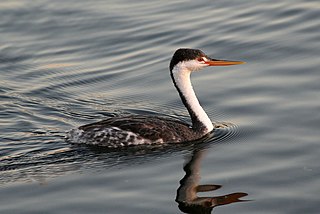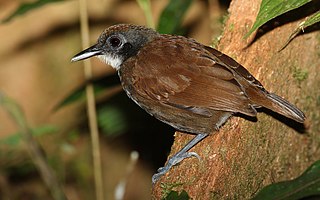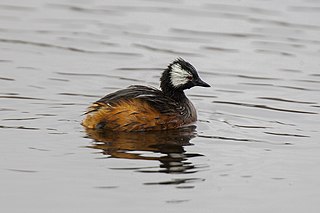
Loons or divers are a group of aquatic birds found in much of North America and northern Eurasia. All living species of loons are members of the genus Gavia, family Gaviidae and order Gaviiformes.

Grebes are aquatic diving birds in the order Podicipediformes. Grebes are widely distributed freshwater birds, with some species also found in marine habitats during migration and winter. Most grebes fly, although some flightless species exist, most notably in stable lakes. The order contains a single family, the Podicipedidae, which includes 22 species in six extant genera.

The horned grebe or Slavonian grebe is a relatively small and threatened species of waterbird in the family Podicipedidae. There are two subspecies: P. a. auritus, which breeds in Eurasia, and P. a. cornutus, which breeds in North America. The Eurasian subspecies is distributed over most of northern Europe and northern Asia, breeding from Greenland east to the Russian Far East. The North American subspecies spans most of Canada and some of the United States. The species got its name from large patches of yellowish feathers located behind the eyes, called "horns", that the birds can raise and lower at will..

The black-necked grebe or eared grebe is a member of the grebe family of water birds. It was described in 1831 by Christian Ludwig Brehm. There are currently three accepted subspecies, including the nominate subspecies. Its breeding plumage features distinctive ochre-coloured feathers which extend behind its eye and over its ear coverts. The rest of the upper parts, including the head, neck, and breast, are coloured black to blackish brown. The flanks are tawny rufous to maroon-chestnut, and the abdomen is white. In its non-breeding plumage, this bird has greyish-black upper parts, including the top of the head and a vertical stripe on the back of the neck. The flanks are also greyish-black. The rest of the body is a white or whitish colour. The juvenile has more brown in its darker areas. The subspecies californicus can be distinguished from the nominate by the former's usually longer bill. The other subspecies, P. n. gurneyi, can be differentiated by its greyer head and upper parts and by its smaller size. P. n. gurneyi can also be told apart by its lack of a non-breeding plumage. This species is present in parts of Africa, Eurasia, and the Americas.

Scolopacidae is a large family of shorebirds, or waders, which mainly includes many species known as sandpipers, but also others such as woodcocks, curlews and snipes. The majority of these species eat small invertebrates picked out of the mud or soil. Different lengths of bills enable different species to feed in the same habitat, particularly on the coast, without direct competition for food.

The western grebe is a species in the grebe family of water birds. Folk names include "dabchick", "swan grebe" and "swan-necked grebe".

Clark's grebe is a North American waterbird species in the grebe family. Until the 1980s, it was thought to be a pale morph of the western grebe, which it resembles in size, range, and behavior. Intermediates between the two species are known.

The American white ibis is a species of bird in the ibis family, Threskiornithidae. It is found from the southern half of the US East Coast, along the Gulf Coast states and south through most of the Caribbean coastal regions of Central America. This particular ibis species is a medium-sized wading bird, possessing an overall white plumage with black wing-tips, and having the typical downward-curving bill of the ibises, though of a bright red-orange color, the same hue as its long legs. Males are larger and have longer bills than females. The breeding range runs along the Gulf and Atlantic Coast, and the coasts of Mexico and Central America. Outside the breeding period, the range extends further inland in North America and also includes the Caribbean. It is also found along the northwestern South American coastline in Colombia and Venezuela. Populations in central Venezuela overlap and interbreed with the scarlet ibis. The two have been classified by some authorities as a single species.

The antbirds are a large passerine bird family, Thamnophilidae, found across subtropical and tropical Central and South America, from Mexico to Argentina. There are more than 230 species, known variously as antshrikes, antwrens, antvireos, fire-eyes, bare-eyes and bushbirds. They are related to the antthrushes and antpittas, the tapaculos, the gnateaters and the ovenbirds. Despite some species' common names, this family is not closely related to the wrens, vireos or shrikes.

The American coot, also known as a mud hen or pouldeau, is a bird of the family Rallidae. Though commonly mistaken for ducks, American coots are only distantly related to ducks, belonging to a separate order. Unlike the webbed feet of ducks, coots have broad, lobed scales on their lower legs and toes that fold back with each step to facilitate walking on dry land. Coots live near water, typically inhabiting wetlands and open water bodies in North America. Groups of coots are called covers or rafts. The oldest known coot lived to be 22 years old.

The black-chinned hummingbird is a hummingbird occupying a broad range of habitats. Its summer range is in the western United States and southwestern Canada. It is migratory, wintering as far south as Mexico. In sunlight, the gorget of iridescent purple feathers bordering its black chin is noticeable.

The tree swallow is a migratory bird of the family Hirundinidae. Found in the Americas, the tree swallow was first described in 1807 by French ornithologist Louis Vieillot as Hirundo bicolor. It has since been moved to its current genus, Tachycineta, within which its phylogenetic placement is debated. The tree swallow has glossy blue-green upperparts, with the exception of the blackish wings and tail, and white underparts. The bill is black, the eyes dark brown, and the legs and feet pale brown. The female is generally duller than the male, and the first-year female has mostly brown upperparts, with some blue feathers. Juveniles have brown upperparts, and gray-brown-washed breasts. The tree swallow breeds in the US and Canada. It winters along southern US coasts south, along the Gulf Coast, to Panama and the northwestern coast of South America, and in the West Indies.

The broad-winged hawk is a medium-sized hawk of the genus Buteo. During the summer, some subspecies are distributed over eastern North America, as far west as British Columbia and Texas; they then migrate south to winter in the Neotropics from Mexico south to southern Brazil. Other subspecies are all-year residents on Caribbean islands. As in most raptors, females are slightly larger than males. Broad-winged hawks' wings are relatively short and broad with a tapered, somewhat pointed appearance. The two types of coloration are a dark morph with fewer white areas and a light morph that is more pale overall. Although the broad-winged hawk's numbers are relatively stable, populations are declining in some parts of its breeding range because of forest fragmentation.

The northern mockingbird is a mockingbird commonly found in North America, of the family Mimidae. The species is also found in some parts of the Caribbean, as well as on the Hawaiian Islands. It is typically a permanent resident across much of its range, but northern mockingbirds may move farther south during inclement weather or prior to the onset of winter. The northern mockingbird has gray to brown upper feathers and a paler belly. Its tail and wings have white patches which are visible in flight.

The blue-footed booby is a marine bird native to subtropical and tropical regions of the eastern Pacific Ocean. It is one of six species of the genus Sula – known as boobies. It is easily recognizable by its distinctive bright blue feet, which is a sexually selected trait and a product of their diet. Males display their feet in an elaborate mating ritual by lifting them up and down while strutting before the female. The female is slightly larger than the male and can measure up to 90 cm (35 in) long with a wingspan up to 1.5 m (5 ft).

The flying steamer duck, also known as the flying steamer-duck or flying steamerduck, is a species of South American duck in the family Anatidae.

The Hispaniolan woodpecker is a medium-sized woodpecker endemic to the Caribbean island of Hispaniola.

The white-tufted grebe, also known as Rolland's grebe, is a species of grebe in the family Podicipedidae. Found in the southern and western South America, its natural habitat is freshwater lakes, ponds and sluggish rivers and streams.

Golden eagles usually mate for life. A breeding pair is formed in a courtship display. This courtship includes undulating displays by both in the pair, with the male bird picking up a piece of rock and dropping it only to enter into a steep dive and catch it in mid-air, repeating the maneuver 3 or more times. The female takes a clump of earth and drops and catches it in the same fashion. Small sticks may also be used in this display. Compared to the bald eagle, golden eagles do not repeat courtship displays annually and rarely engage in talon-locking downward spirals.

Allofeeding is a type of food sharing behaviour observed in cooperatively breeding species of birds. Allofeeding refers to a parent, sibling or unrelated adult bird feeding altricial hatchlings, which are dependent on parental care for their survival. Allofeeding also refers to food sharing between adults of the same species. Allofeeding can occur between mates during mating rituals, courtship, egg laying or incubation, between peers of the same species, or as a form of parental care.


























